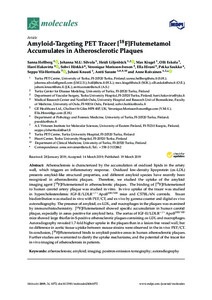Amyloid-Targeting PET Tracer [18F]Flutemetamol Accumulates in Atherosclerotic Plaques
Sanna Hellberg; Johanna M.U. Silvola; Heidi Liljenbäck; Max Kiugel; Olli Eskola; Harri Hakovirta; Sohvi Hörkkö; Veronique Morisson-Iveson; Ella Hirani; Pekka Saukko; Seppo Ylä-Herttuala; Juhani Knuuti; Antti Saraste; Anne Roivainen
https://urn.fi/URN:NBN:fi-fe2021042825980
Tiivistelmä
Atherosclerosis is characterized by the accumulation of oxidized lipids in the artery wall, which triggers an inflammatory response. Oxidized low-density lipoprotein (ox-LDL) presents amyloid-like structural properties, and different amyloid species have recently been recognized in atherosclerotic plaques. Therefore, we studied the uptake of the amyloid imaging agent [ 18 F]Flutemetamol in atherosclerotic plaques. The binding of [ 18 F]Flutemetamol to human carotid artery plaque was studied in vitro. In vivo uptake of the tracer was studied in hypercholesterolemic IGF-II/LDLR − / − ApoB 100/100 mice and C57BL/6N controls. Tracer biodistribution was studied in vivo with PET/CT, and ex vivo by gamma counter and digital ex vivo autoradiography. The presence of amyloid, ox-LDL, and macrophages in the plaques was examined by immunohistochemistry. [ 18 F]Flutemetamol showed specific accumulation in human carotid plaque, especially in areas positive for amyloid beta. The aortas of IGF-II/LDLR − / − ApoB 100/100 mice showed large thioflavin-S-positive atherosclerotic plaques containing ox-LDL and macrophages. Autoradiography revealed 1.7-fold higher uptake in the plaques than in a lesion-free vessel wall, but no difference in aortic tissue uptake between mouse strains were observed in the in vivo PET/CT. In conclusion, [ 18 F]Flutemetamol binds to amyloid-positive areas in human atherosclerotic plaques. Further studies are warranted to clarify the uptake mechanisms, and the potential of the tracer for in vivo imaging of atherosclerosis in patients.
Kokoelmat
- Rinnakkaistallenteet [27094]
